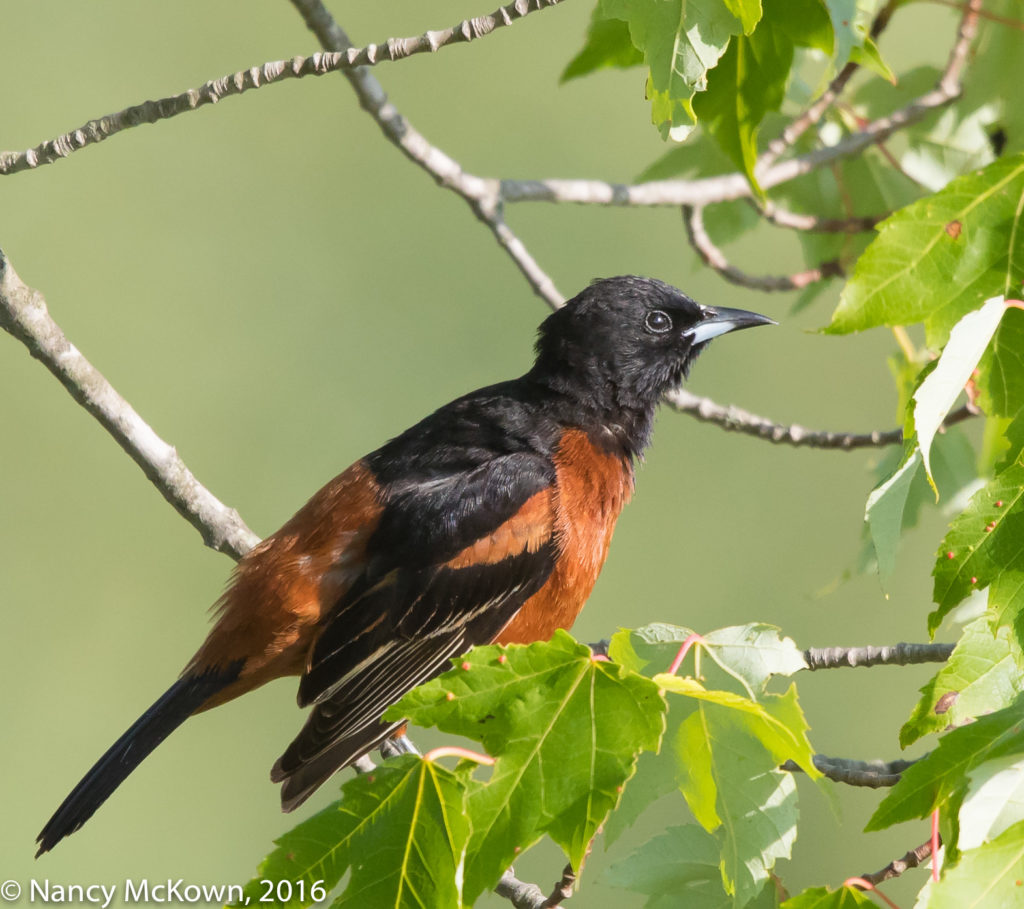Photographing An Orchard Oriole
It was only 8:30 a.m., a couple days before summer solstice, when I spotted my first adult male Orchard Oriole. The male Orchard Oriole looks very different from the female with his velvety black head and glossy russet colored breast and lower back. True to their name, this species are found in semi-open spaces like orchards (and rarely at feeders like Baltimore Orioles). Most E-bird maps classify Orchard Orioles as uncommon breeders in Michigan.
(Note: I saw and photographed a female or fledgling Orchard Oriole last year.)

ISO1600; f/9; 1/1000 Second
Glare Control
On this morning, sunrise was 6:10 am, at which time we were at another location. That sublime early morning light that adorns birds with a soft golden glow had long past.
Even though the sun was not that high in the sky, I had a terrible time (while in the car) dealing with distracting glare coming from the many reflective maple leaves. (NOTE: Sadly, I can not coax a bird to move into a shaded environment. I can better control these uneven bits of radiance when photographing people. The glare caused by bald heads and eye-glasses are a piece of cake to remedy because you can tell people how to pose, where to stand and, if necessary, move the camera.)
Polarizers
For this shoot, it would have helped if I had taken off my polarized sunglasses. If I had, I would have been able to see the brassiness of the maple leaves …so blatant that it competed with my subject for viewer attention.
Harsh light creates strong contrasts. To cut the glare, photographers in more manageable outdoor environments use a circular polarizing filter on their lenses. To use circular polarizing filters optimally, you must position your camera correctly… (preferably 90 degrees to the bird) and rotate the filter until you block certain wavelengths of light. (NOTE: Filters cut down available light considerably – from 1-2 stops.)
Circular Polarizers aren’t practical for long telephoto lens wildlife photography – and especially for birds as restless and unpredictable as this Orchard Oriole. Consequently, no filter threads are provided on the ends of most monster 500mm lenses. Instead a drop-in gel filter holder is provided near the base of the lens .

Much less Leaf Glare; but Branches are Distracting.
ISO1250; f/9; 1/1250 Second
Impatience Takes Over
Tracking a bird with your eyes is easy…..even within the limitations of a car. Not so easy is tracking a lively bird with a cumbersome camera and 500mm lens while in a car.
This male Orchard Oriole was flying low, bopping between the glare filled Maple leaves on the north side of the road and a Cyprus tree on the south. The camera was resting on the door window pointing toward the Maple tree. I was hoping that the bird would cross the road and perch in front of the camera. He eventually did, but not right away. Impatience got the best of me.
For some reason, I decided that to successfully photograph this bird, I needed to reposition the camera to face the opposite direction. My husband was in the driver’s seat, making it impossible to secure the lens on that door window. With the oriole watching me, I opened my car door, threw a towel on the roof of the car, lugged my camera out and rested it on the towel, and then re-situated the unwieldy lens to point in the direction of the bird. (Whew!)
Before I could get off a shot, the Orchard Oriole dashed across the road again —to the very perch on which the lens was trained before I hauled it out of the car. He didn’t stay there long. With a big sigh, I got back in the car.
Actions that rise from frustration and exasperation are neither practical nor productive in bird photography. For unexpected bird sightings, patience is key.
I stayed in the car, rested the camera on the car door window ledge, watched, waited, and tried to calm down. Eventually the Oriole did return to the maple tree allowing me to successfully burst away.
Birds Don’t Wait for the Photographer
Turning the car around to face the opposite direction would have created too much of a disturbance. Getting out of the car to set up the tripod would also have chased the bird off. I’ve tried both of these strategies often enough- and no bird has ever waited for me to get situated. I can be quick and efficient.. but all that movement is neither quiet nor covert, especially when it happens at the spur of the moment. It is simply too much human activity for a bird to endure.
Patience
Patience is the mother of all virtue in bird photography. It is the key to help you let go of your expectations and drop those feelings of frustration. Most important of all, patience helps you rise above the feelings of urgency and optimally use your experience, enthusiasm and talent. Chances are you won’t miss out on anything.









That goal of Patience is certainly applicable to sooooooooo many aspects of our lives!